Training your delts is a essential part of strengthening and shaping your shoulders. Whether you are a seasoned workout veteran or starting your first training plan, the workouts below will help you meet your fitness goals.
dumbbell w-press
1. Start by standing upright with your feet shoulder-width apart. Hold a dumbbell in each hand with your palms facing forward.
2. Bend your elbows to a 90-degree angle, keeping your upper arms parallel to the floor. This is your starting position.
3. Press the dumbbells up and out diagonally in a "W" shape. Keep your wrists straight and your elbows slightly bent at the top of the movement.
4. Pause for a moment at the top, then slowly lower the dumbbells back to the starting position.
5. Repeat this movement for your desired number of repetitions.
6. Ensure to keep your core engaged and your back straight throughout the exercise to avoid any injury.
7. Remember to breathe in as you lower the weights and breathe out as you press them up.
8. Start with lighter weights and gradually increase as you get stronger to avoid straining your muscles.
This exercise primarily targets your deltoid muscles but also works your triceps and upper back.
dumbbell upright shoulder external rotation
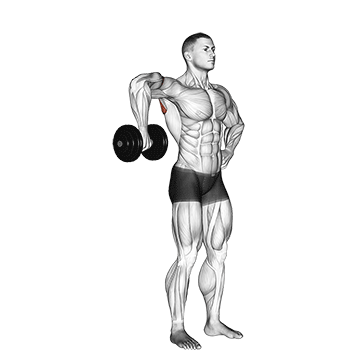
1. Stand upright with your feet shoulder-width apart. Hold a dumbbell in each hand with your palms facing towards your body.
2. Bend your elbows to a 90-degree angle, keeping your upper arms close to your body. The dumbbells should be at about waist level.
3. Slowly rotate your shoulders, lifting the dumbbells up and out to the sides. Keep your elbows bent at 90 degrees throughout the movement.
4. Continue lifting until your forearms are vertical and parallel to each other. Your elbows should be at shoulder level and your palms should be facing forward.
5. Pause for a moment at the top of the movement, then slowly lower the dumbbells back to the starting position.
6. Repeat for the desired number of repetitions.
Remember to keep your back straight and your core engaged throughout the exercise. Avoid using your back or wrists to lift the weights; the movement should come from your shoulders. Start with a light weight and gradually increase as your strength improves.
dumbbell upright row (back pov)
_Shoulders_360.gif)
1. Stand upright with your feet shoulder-width apart. Hold a dumbbell in each hand with your palms facing your body. This is your starting position.
2. Keeping the dumbbells close to your body, raise them towards your chin, leading with your elbows. Your elbows should always be higher than your forearms.
3. Continue to lift the dumbbells until they nearly touch your chin. Ensure your shoulders are down and back throughout the movement.
4. Pause for a moment at the top of the movement, then slowly lower the dumbbells back to the starting position.
5. Repeat this movement for the desired number of repetitions.
Remember to keep your core engaged and back straight throughout the exercise. Avoid using your back or swinging the weights to lift them, instead focus on using your shoulder muscles.
dumbbell upright row
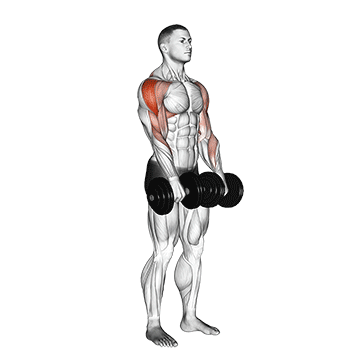
To perform the dumbbell upright row, start by standing upright with your feet shoulder-width apart. Hold a dumbbell in each hand with your palms facing your body. Your arms should be fully extended and the dumbbells should be resting on your thighs.
Begin the exercise by lifting the dumbbells straight up towards your chin, keeping them close to your body. Your elbows should lead the movement and always be higher than your forearms. Continue lifting until the dumbbells reach chest level, or just below your chin.
Pause for a moment at the top of the movement, then slowly lower the dumbbells back down to the starting position. Ensure that you maintain control of the weights throughout the entire movement, don't let them just drop back down.
Remember to keep your back straight and your core engaged throughout the exercise. Avoid using your back or legs to lift the weights; the movement should be driven by your shoulders and arms.
Repeat the exercise for your desired number of repetitions. This exercise primarily targets the deltoids, but also works the traps and biceps.
dumbbell standing palms in press
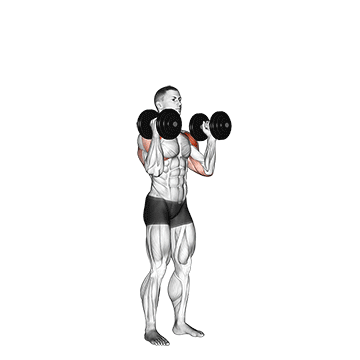
To perform the dumbbell standing palms in press, start by standing upright with your feet shoulder-width apart. Hold a dumbbell in each hand at shoulder level with your palms facing each other. This is your starting position.
Engage your core and press the dumbbells upward until your arms are fully extended above your head. Ensure your palms are still facing each other at the top of the movement.
Pause for a moment at the top, then slowly lower the dumbbells back to the starting position. This completes one repetition.
Ensure your back remains straight and your movements are controlled throughout the exercise. Avoid using your back or legs to help lift the weights; your delts should be doing the work.
Repeat for the desired number of repetitions. This exercise primarily targets the deltoid muscles in your shoulders.
dumbbell standing overhead press
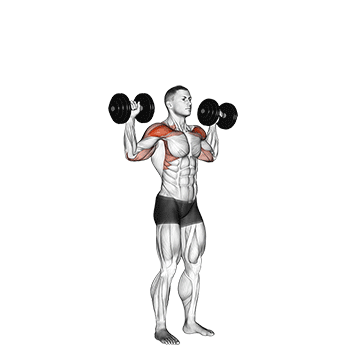
1. Stand upright with your feet shoulder-width apart. Hold a dumbbell in each hand at shoulder level with your palms facing each other.
2. Engage your core and keep your back straight. This is your starting position.
3. Push the dumbbells upward until your arms are fully extended above your head. Ensure your movements are controlled and steady, and avoid locking your elbows at the top of the movement.
4. Pause for a moment at the top, then slowly lower the dumbbells back to the starting position at shoulder level.
5. Repeat this movement for your desired number of repetitions. Ensure to keep your body stable throughout the exercise, avoiding any swaying or leaning back.
6. Remember to breathe in as you lower the dumbbells and breathe out as you press them overhead.
7. For optimal results, ensure your movements are slow and controlled, focusing on the muscle contraction and not on the weights you are lifting.
8. Always use a weight that's challenging to lift but doesn't compromise your form.
Remember, the focus of this exercise is on the delts, so ensure you're feeling the tension in this muscle group throughout the exercise.
dumbbell standing one arm palm in press
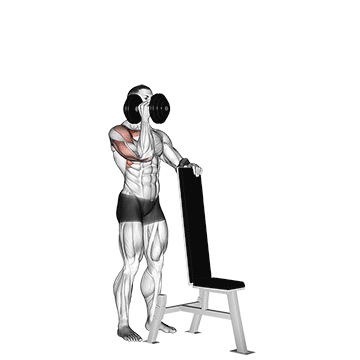
1. Stand upright with your feet shoulder-width apart. Hold a dumbbell in one hand, with your palm facing inwards towards your body. Your arm should be bent at a 90-degree angle, with the dumbbell at shoulder level.
2. Engage your core and keep your back straight. This is your starting position.
3. Exhale and press the dumbbell upwards until your arm is fully extended. Ensure your palm is still facing inwards and your arm is close to your ear.
4. Pause for a moment at the top of the movement, then slowly lower the dumbbell back to the starting position while inhaling.
5. Repeat the movement for your desired number of repetitions.
6. Once you've completed your set, switch the dumbbell to your other hand and repeat the exercise.
Remember to keep your body still throughout the exercise, with the movement coming only from your shoulder and arm. This will ensure you're targeting your delts effectively.
dumbbell standing front raise above head
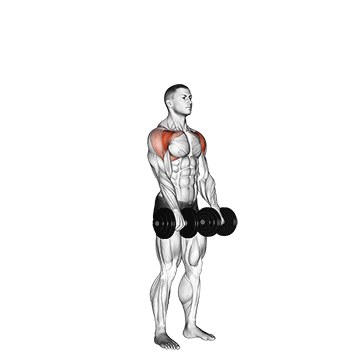
1. Stand upright with your feet shoulder-width apart. Hold a dumbbell in each hand with your palms facing your body. This is your starting position.
2. Keeping your back straight and your core engaged, slowly lift the dumbbells up in front of you. Keep your arms slightly bent at the elbows and raise the weights until they are at shoulder height.
3. Continue to lift the dumbbells above your head until your arms are fully extended. Ensure your arms are in line with your ears and your palms are facing each other.
4. Pause for a moment at the top of the movement, then slowly lower the dumbbells back down to shoulder height.
5. Continue to lower the weights back down to the starting position in a controlled manner.
6. Repeat the movement for the desired number of repetitions.
Remember to keep your movements slow and controlled, and avoid using your back or swinging the weights to lift them. The focus should be on your delts doing the work. If the weights are too heavy and you can't maintain proper form, reduce the weight.
dumbbell standing around world
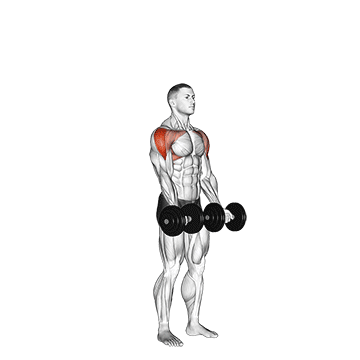
1. Stand upright with your feet shoulder-width apart. Hold a dumbbell in each hand with your palms facing towards your body. This is your starting position.
2. Keeping your arms slightly bent, raise the dumbbells out to your sides until they reach shoulder height.
3. From this position, move the dumbbells in a semi-circular motion in front of your body until they meet at the center.
4. Now, reverse the motion, moving the dumbbells back out to your sides and then down to the starting position.
5. Ensure that your torso remains stationary throughout the exercise and the movement is controlled by your shoulders.
6. Repeat this motion for the desired number of repetitions.
Remember to keep your back straight and your core engaged throughout the exercise. Also, avoid using your back or swinging your body to lift the weights; your shoulders should be doing the work.
dumbbell standing alternate raise
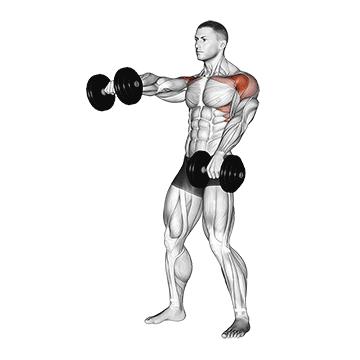
1. Stand upright with your feet shoulder-width apart. Hold a dumbbell in each hand with your arms fully extended at your sides. Your palms should be facing your body. This is your starting position.
2. Keeping your body stationary and your elbows slightly bent, raise one dumbbell to the front of your body. Lift it until your arm is slightly above parallel to the floor or until you feel a slight stretch on your delts.
3. Pause for a moment at the top of the movement, then slowly lower the dumbbell back to the starting position.
4. Repeat the movement with the other arm. This completes one repetition.
5. Continue alternating arms for the desired number of repetitions.
Remember to keep your back straight and your movements controlled throughout the exercise. Avoid using your back or swinging the weights to lift them, as this can lead to injury. Instead, focus on using your delts to lift the weights.
dumbbell standing alternate overhead press
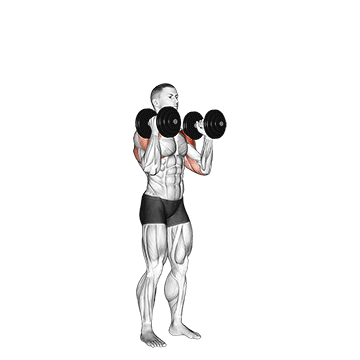
1. Stand upright with your feet shoulder-width apart. Hold a dumbbell in each hand at shoulder level with your palms facing each other.
2. Engage your core and keep your back straight. This is your starting position.
3. Lift one dumbbell straight up until your arm is fully extended above your head. Keep your other arm stationary at shoulder level.
4. Slowly lower the dumbbell back to the starting position while maintaining control.
5. Repeat the movement with the other arm. This completes one rep.
6. Continue alternating arms for the desired number of repetitions.
7. Remember to keep your movements controlled, avoid using momentum to lift the weights, and keep your body stable throughout the exercise.
8. Breathe in as you lower the dumbbell and breathe out as you press it overhead.
9. Keep your gaze forward and avoid arching your back as you press the dumbbell overhead.
10. This exercise can be performed for 3-4 sets with 10-15 repetitions per set.
Remember, it's important to use a weight that's challenging but allows you to maintain good form throughout the exercise.
dumbbell single arm overhead carry
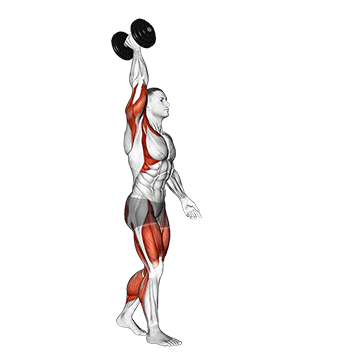
1. Start by selecting a dumbbell of appropriate weight. Remember, it's always better to start light and gradually increase the weight as you get comfortable with the exercise.
2. Stand straight with your feet shoulder-width apart. Hold the dumbbell in one hand, let it hang at arm's length by your side.
3. Raise the dumbbell overhead by extending your arm. Ensure your palm is facing forward and your arm is directly above your shoulder. This is your starting position.
4. Keep your core engaged, back straight, and gaze forward. Begin to walk forward, taking slow and controlled steps.
5. As you walk, keep the dumbbell overhead, ensuring your arm remains straight. Avoid letting the dumbbell sway or your arm bend.
6. Continue walking for a set distance or time, maintaining the overhead position.
7. Once you've completed the walk, carefully lower the dumbbell back to your side.
8. Repeat the exercise with the dumbbell in your other hand. This completes one round of the exercise.
9. Perform the desired number of rounds, alternating arms each time.
Remember to keep your movements controlled and steady throughout the exercise. The focus should be on maintaining the overhead position while moving, which will engage and strengthen your delts.
dumbbell side lying one hand raise
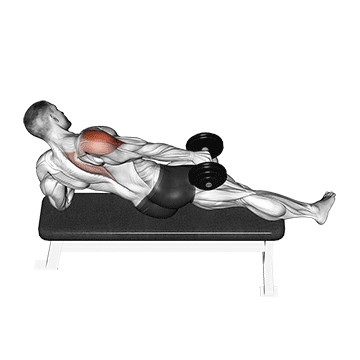
1. Start by selecting a dumbbell of appropriate weight. Remember, it's better to start light and increase weight as you get comfortable with the exercise.
2. Lie down on your side on a flat bench with your legs extended straight out. The dumbbell should be in the hand of the arm that's on top.
3. Your lower arm can be extended in front of you for balance. The hand with the dumbbell should be resting on your hip with your elbow slightly bent.
4. Slowly raise the dumbbell up and out to your side. Keep your arm slightly bent at the elbow and your wrist straight. The movement should come from your shoulder, not your arm.
5. Lift the dumbbell until it's about level with your shoulder, or as high as you can comfortably go. Pause for a moment at the top of the movement.
6. Slowly lower the dumbbell back down to your hip. This should be a controlled movement, don't let the weight just drop.
7. Repeat this movement for your desired number of reps, then switch sides and do the same number of reps with the other arm.
8. Remember to keep your core engaged throughout the exercise to help maintain balance and stability.
This exercise is great for targeting the deltoid muscles in your shoulders. Be sure to keep the movement slow and controlled, focusing on the muscle contraction and not on the weights you're lifting.
dumbbell seated shoulder press (parallel grip)
_Shoulders_360.gif)
1. Start by sitting on a bench with back support, holding a dumbbell in each hand. Your feet should be firmly planted on the floor.
2. Lift the dumbbells to shoulder height one at a time, using your thighs to help propel them into position. The dumbbells should be just to the sides of your shoulders, with your palms facing each other. This is your starting position.
3. Keep your back pressed against the bench and your core engaged. Push the dumbbells up and together, extending your arms fully but without locking your elbows.
4. Pause for a moment at the top of the movement, then slowly lower the dumbbells back to the starting position.
5. Repeat for the desired number of repetitions.
6. Ensure to keep your movements controlled, focusing on the contraction of your deltoid muscles rather than the weights you're lifting.
7. Avoid using your back or legs to help you lift the weights; your shoulders should do the work.
8. Remember to breathe in as you lower the weights and breathe out as you lift them.
9. Always use a weight that's challenging but allows you to perform the exercise with proper form. If you can't do the exercise without straining or losing form, reduce the weight.
10. As with any exercise, it's important to warm up before starting and cool down afterwards.
dumbbell seated shoulder press
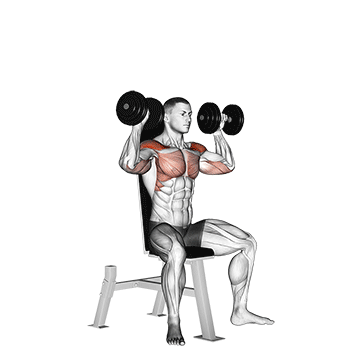
1. Start by sitting on a bench with back support, holding a dumbbell in each hand. Your feet should be firmly planted on the ground.
2. Lift the dumbbells to shoulder height one at a time, using your thighs to help propel them into position. The palms of your hands should be facing forward.
3. Keep your back pressed against the bench and your core engaged. This is your starting position.
4. Exhale and push the dumbbells up until your arms are fully extended above your head. Do not lock your elbows.
5. Pause for a moment at the top of the movement, then slowly lower the dumbbells back down to the starting position while inhaling.
6. Repeat for the recommended amount of repetitions.
Remember to keep your movements controlled, don't let the dumbbells drop quickly. The slower you move, the more muscle fibers you engage.
dumbbell seated lateral raise v. 2
Begin by sitting on a flat bench with your back straight. Hold a dumbbell in each hand with your palms facing each other. Your arms should be fully extended and resting at your sides. This is your starting position.
Breathe out and slowly lift the dumbbells to your side until your arms are almost parallel to the floor. Keep your torso stationary and your elbows slightly bent throughout the movement. The lifting motion should be executed by your shoulders, not your biceps.
Pause for a second at the top of the movement, then slowly lower the dumbbells back to the starting position while breathing in.
Ensure that you maintain control of the dumbbells at all times, do not allow them to control your movement.
Repeat this movement for the desired number of repetitions.
Remember to keep your back straight and your movements smooth throughout the exercise. Avoid using your back or swinging the weights to lift the dumbbells, as this can lead to injury.
dumbbell seated lateral raise
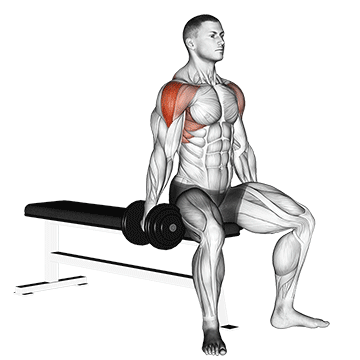
1. Start by sitting on a flat bench with your feet firmly planted on the ground. Hold a dumbbell in each hand with your palms facing each other and your arms fully extended at your sides.
2. Keep your back straight and your chest up. This is your starting position.
3. Slowly lift the dumbbells out to your sides, keeping your elbows slightly bent. Continue to raise the weights until your arms are parallel to the floor. Ensure that you are lifting the weights with your shoulders, not your biceps or triceps.
4. Pause for a moment at the top of the movement, then slowly lower the dumbbells back to the starting position.
5. Repeat this movement for the desired number of repetitions.
6. Remember to keep your movements controlled, don't use momentum to lift the weights. The focus should be on the delts, so make sure you're feeling the contraction in your shoulders.
7. Avoid shrugging your shoulders or arching your back during the exercise. If you find yourself doing this, consider reducing the weight until you can perform the exercise with proper form.
8. This exercise can be performed in sets of 10-15 repetitions, depending on your fitness level and goals.
Remember, it's always important to warm up before starting any exercise routine and cool down afterwards.
dumbbell seated front raise
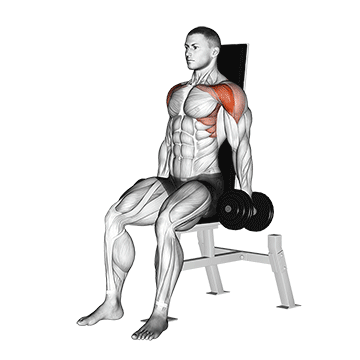
Begin by sitting on a flat bench with your feet firmly planted on the ground. Hold a dumbbell in each hand with your palms facing your body and your arms fully extended. This is your starting position.
Slowly lift the dumbbells in front of you while keeping your arms slightly bent at the elbows. Continue to raise the weights until your arms are slightly above parallel to the floor. Ensure that you are lifting the weights with your shoulders and not your biceps.
Pause for a moment at the top of the movement, then slowly lower the dumbbells back to the starting position.
Remember to keep your back straight and your movements controlled throughout the exercise. Avoid swinging the weights or using momentum to lift them.
Repeat for the recommended number of repetitions.
This exercise targets the front part of your deltoids, helping to build shoulder strength and definition.
dumbbell seated bent arm lateral raise
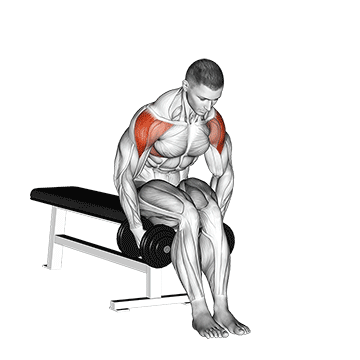
1. Start by sitting on a flat bench with your feet firmly planted on the ground. Hold a dumbbell in each hand with your palms facing each other.
2. Bend your elbows at a 90-degree angle, keeping your upper arms aligned with your torso and your forearms perpendicular to the floor. This is your starting position.
3. Keeping your torso stationary and your elbows bent, raise the dumbbells out to the sides until your upper arms are parallel to the floor. Ensure your wrists, elbows, and shoulders are in the same plane.
4. Pause for a moment at the top of the movement, then slowly lower the dumbbells back to the starting position.
5. Repeat the movement for the desired number of repetitions.
6. Remember to keep your back straight and your core engaged throughout the exercise to protect your spine and maximize the effectiveness of the movement.
7. Avoid using momentum or swinging the weights. The movement should be controlled, with the muscles of the shoulders doing the work.
8. Breathe out as you lift the weights and breathe in as you lower them back down.
9. This exercise can be performed in sets of 10-15 repetitions, depending on your fitness level and the weight of the dumbbells.
10. Always ensure to use a weight that is challenging but allows you to maintain proper form throughout the exercise.
dumbbell seated alternate shoulder
1. Start by sitting on a bench with a back support, holding a dumbbell in each hand. Your feet should be flat on the floor, about hip-width apart.
2. Position the dumbbells at shoulder level with your palms facing forward. This is your starting position.
3. Slowly lift one dumbbell straight up until your arm is fully extended above your head. Keep your other arm still at shoulder level.
4. Hold the position for a second, then slowly lower the dumbbell back to the starting position.
5. Repeat the movement with the other arm. This completes one rep.
6. Continue alternating arms for the desired number of repetitions.
7. Remember to keep your back straight and your core engaged throughout the exercise to protect your spine and maximize the effectiveness of the movement.
8. Avoid using your back or neck to lift the weights; your shoulders should be doing the work. If you find yourself straining, consider using lighter weights.
9. Breathe out as you lift the dumbbell and breathe in as you lower it back down. This will help maintain a steady rhythm and ensure your muscles are getting the oxygen they need.
10. Perform this exercise for 2-3 sets of 8-12 reps each, or as recommended by your fitness professional.
dumbbell seated alternate press
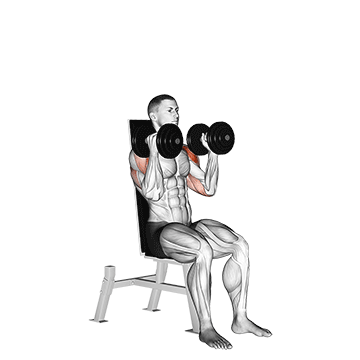
1. Start by sitting on a flat bench with a dumbbell in each hand. Your feet should be flat on the floor, about shoulder-width apart.
2. Hold the dumbbells at shoulder level with your palms facing forward. This is your starting position.
3. Push one dumbbell up until your arm is fully extended above your shoulder. Keep your other arm still at the shoulder level.
4. As you lower the first dumbbell back to the starting position, simultaneously press the other dumbbell up.
5. Continue alternating between each arm, ensuring you maintain control of the dumbbells at all times.
6. Keep your back straight and your core engaged throughout the exercise to protect your spine.
7. Repeat for the desired number of reps.
Remember, the focus of this exercise is on the delts, so make sure you're not using your back or neck to lift the weights. The movement should be controlled and deliberate, not fast or jerky.
dumbbell seated alternate front raise
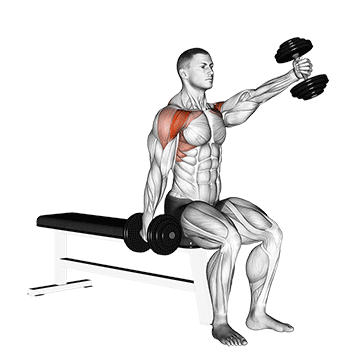
1. Start by sitting on a flat bench with a dumbbell in each hand. Your feet should be flat on the floor, about hip-width apart.
2. Hold the dumbbells with your palms facing your body and your arms fully extended. This is your starting position.
3. Keeping your torso stationary, lift one dumbbell in front of you. Your arm should be slightly bent at the elbow and raised until it is roughly parallel with the floor.
4. Pause for a moment at the top of the movement, then slowly lower the dumbbell back to the starting position.
5. Repeat the movement with the other arm. This completes one rep.
6. Continue alternating arms for the desired number of repetitions.
Remember to keep your back straight and your movements controlled throughout the exercise. Avoid using your back or swinging the weights to lift them, as this can lead to injury. The focus should be on your delts doing the work.
dumbbell scott press
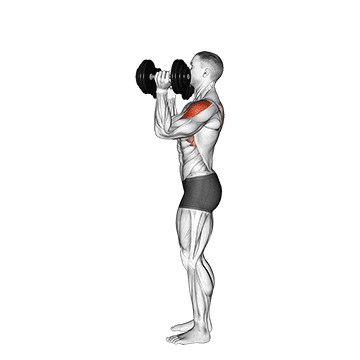
To perform the Dumbbell Scott Press, follow these steps:
1. Start by standing upright with your feet shoulder-width apart. Hold a dumbbell in each hand at shoulder level with your palms facing forward.
2. Push the dumbbells upward until your arms are almost fully extended, but keep a slight bend in your elbows to avoid locking them. This is your starting position.
3. Lower the dumbbells to the sides by bending your elbows and moving your hands outwards. Your elbows should move out to the sides and slightly back, and your hands should move in a semi-circular motion. Lower the weights until your upper arms are parallel to the floor.
4. Pause for a moment at the bottom of the movement, then push the dumbbells back up to the starting position by reversing the motion. Make sure to keep your palms facing forward throughout the exercise.
5. Repeat for the desired number of repetitions.
Remember to keep your back straight and your core engaged throughout the exercise to protect your spine. Also, avoid using your back or legs to help lift the weights; your shoulders should be doing most of the work. If you find it difficult to maintain proper form, consider using lighter weights.
dumbbell rotation reverse fly
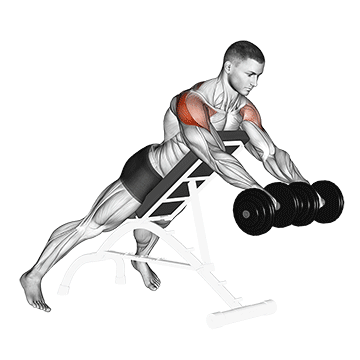
1. Start by standing straight with your feet shoulder-width apart. Hold a dumbbell in each hand with your palms facing each other.
2. Bend your knees slightly and lean forward from your hips, not your waist. Keep your back straight and almost parallel to the floor. This is your starting position.
3. Extend your arms straight down from your shoulders, keeping a slight bend in your elbows.
4. In a controlled motion, raise the dumbbells out to the sides and up until they're level with your shoulders, rotating your wrists so that your palms face forward at the top of the movement.
5. Squeeze your shoulder blades together at the top of the movement for a second to maximize the contraction in your delts.
6. Slowly lower the dumbbells back to the starting position, rotating your wrists back to the initial position.
7. Repeat for the desired number of repetitions.
Remember to keep your core engaged throughout the exercise to maintain balance and stability. Also, ensure that you're lifting the weights with your shoulders and not your back or arms. The movement should be slow and controlled, not fast and jerky.
dumbbell reverse fly
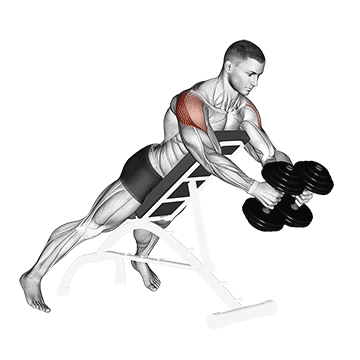
1. Start by selecting a pair of dumbbells of appropriate weight. Remember, it's better to start light and increase weight as you get comfortable with the movement.
2. Stand upright with your feet shoulder-width apart. Hold a dumbbell in each hand with your palms facing each other.
3. Slightly bend your knees and hinge forward at the waist until your torso is almost parallel to the floor. Keep your back straight and your head in a neutral position.
4. Extend your arms directly below your chest, keeping a slight bend in your elbows. This is your starting position.
5. Keeping your torso still, lift the dumbbells out to the sides and up until they're in line with your shoulders. Your elbows should remain slightly bent throughout the movement.
6. Squeeze your shoulder blades together at the top of the movement, then slowly lower the dumbbells back to the starting position.
7. Repeat for the desired number of repetitions.
Remember to keep your movements slow and controlled, focusing on the muscle contraction and not on the weights you are lifting. Avoid using your back or momentum to lift the weights; your shoulders should do the work.
dumbbell rear lateral raise (support head)
_Shoulders_360.gif)
1. Start by selecting a pair of dumbbells of an appropriate weight that you can lift without straining yourself.
2. Stand upright and hold the dumbbells in each hand by your side. Your palms should be facing your torso.
3. Bend your knees slightly and lean forward from your waist. Keep your back straight and almost parallel to the floor. This is your starting position.
4. Now, lift the dumbbells to your side while keeping your torso stationary. Keep your arms slightly bent at the elbows and the weights under your shoulders. Continue to lift the weights until your arms are parallel to the floor.
5. Pause for a moment at the top of the movement, then slowly lower the dumbbells back to the starting position.
6. Repeat this movement for the desired number of repetitions.
7. For the supported version of this exercise, you can rest your forehead on an incline bench to help maintain your body position and prevent using your lower back to lift the weights.
Remember to keep your movements controlled, don't use your back or other muscles to lift the weights; your shoulders should do the work. Also, avoid using too heavy weights; the key to this exercise is perfect form with a weight you can handle.
dumbbell rear lateral raise
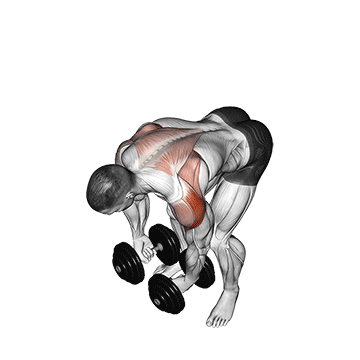
To perform the dumbbell rear lateral raise, start by selecting a pair of dumbbells of appropriate weight. Stand straight with your feet shoulder-width apart. Hold a dumbbell in each hand with your palms facing towards your body.
Bend your knees slightly and lean forward from your hips, keeping your back straight. Your torso should be almost parallel to the floor. Let your arms hang down from your shoulders, perpendicular to the floor. This is your starting position.
Keeping your torso forward and your back straight, lift the dumbbells to your side in a wide arc, keeping your elbows slightly bent. Continue to lift the weights until your arms are parallel to the floor. Ensure that the force is applied by the rear delts, not the hands.
Pause for a moment at the top of the movement, then slowly lower the dumbbells back to the starting position.
Remember to breathe out as you lift the weights and breathe in as you lower them. Repeat this exercise for the recommended number of repetitions.
Ensure that you maintain control of the dumbbells at all times, do not allow them to control your movement. This exercise should be performed with a slow, controlled motion.
Avoid using your back or shoulders to lift the weights; your delts should be doing the work. Keep your abdominal muscles engaged throughout the exercise to protect your spine.
dumbbell rear fly
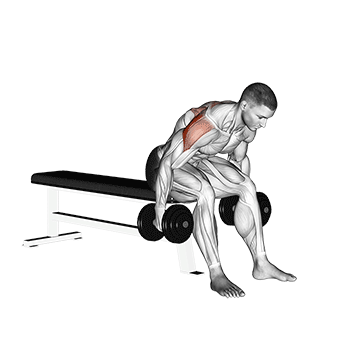
To perform the dumbbell rear fly, start by selecting a pair of dumbbells of appropriate weight. Stand tall with your feet hip-width apart. Hold a dumbbell in each hand with your palms facing each other.
Bend your knees slightly and hinge forward at the waist, keeping your back straight. Your torso should be almost parallel to the floor. Let the dumbbells hang down from your shoulders, keeping your arms slightly bent at the elbows. This is your starting position.
Exhale and lift the dumbbells out to your sides in a wide arc, squeezing your shoulder blades together. Keep your elbows slightly bent throughout the movement. Continue lifting until your arms are parallel to the floor.
Pause for a moment at the top of the movement, then inhale and slowly lower the dumbbells back to the starting position.
Ensure that you are not using your back or swinging the weights to lift the dumbbells. The movement should be controlled, with the focus on your delts doing the work.
Repeat for the desired number of repetitions. This exercise primarily targets the rear deltoids, but also works the upper back and traps.
dumbbell rear delt row_shoulder
To perform the dumbbell rear delt row, follow these steps:
1. Stand upright with a dumbbell in each hand, palms facing your torso. Keep your feet shoulder-width apart.
2. Bend your knees slightly and bring your torso forward by bending at the waist. Keep your back straight until it's almost parallel to the floor. This is your starting position.
3. Now, while keeping the torso stationary, lift the dumbbells to your side, keeping the elbows close to your body. Do not use your biceps to lift the weights; your delts should do the work. Your upper arms should be perpendicular to your torso and the floor. The dumbbells should be level with your shoulders at the top of the movement.
4. Lower the weights back down to the starting position while inhaling.
5. Repeat for the recommended amount of repetitions.
Remember to keep your torso stationary throughout the exercise and move only your arms. Also, keep your back straight and your movements smooth and controlled.
dumbbell rear delt raise
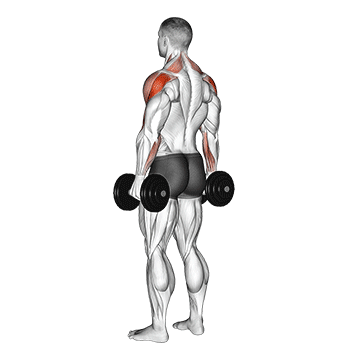
1. Start by selecting a pair of dumbbells of appropriate weight. Remember, it's better to start light and increase weight as you get comfortable with the movement.
2. Stand upright with your feet shoulder-width apart. Hold a dumbbell in each hand with your palms facing towards your body.
3. Slightly bend your knees and hinge forward at the waist until your torso is almost parallel to the floor. Keep your back straight and your head in a neutral position.
4. Extend your arms directly below your shoulders, keeping a slight bend in your elbows. This is your starting position.
5. Keeping your torso stationary, raise the dumbbells out to the sides and upwards in a semicircular arc until they're level with your shoulders. Ensure your elbows and shoulders are moving at the same time and that the movement is controlled.
6. Pause for a moment at the top of the movement, then slowly lower the dumbbells back to the starting position.
7. Repeat this movement for the desired number of repetitions.
Remember to keep your core engaged throughout the exercise to maintain balance and stability. Also, avoid using your back or swinging the weights to lift them. The movement should be driven by the shoulders.
dumbbell raise
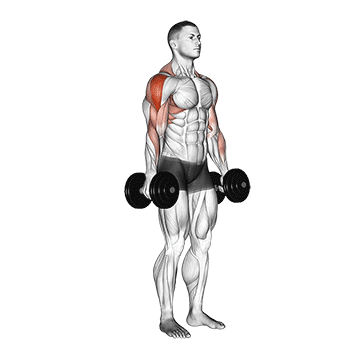
1. Stand upright with your feet shoulder-width apart. Hold a dumbbell in each hand with your arms fully extended at your sides. This is your starting position.
2. Keeping your back straight and your eyes facing forward, slowly raise the dumbbells out to the sides. Keep your arms slightly bent at the elbows and continue lifting until they are parallel with the floor.
3. Pause for a moment at the top of the movement, then slowly lower the dumbbells back to the starting position.
4. Repeat this movement for the desired number of repetitions.
5. Ensure to keep your movements controlled, don't use momentum to lift the weights. The focus should be on your delts doing the work.
6. Remember to breathe in as you lower the weights and breathe out as you lift them.
7. For safety and to ensure proper form, start with lighter weights and gradually increase as your strength improves.
8. Avoid shrugging your shoulders or arching your back during the exercise. Your body should remain stable throughout the movement.
This exercise can be performed in sets of 10-15 repetitions, depending on your fitness level and the weight of the dumbbells.
dumbbell push press
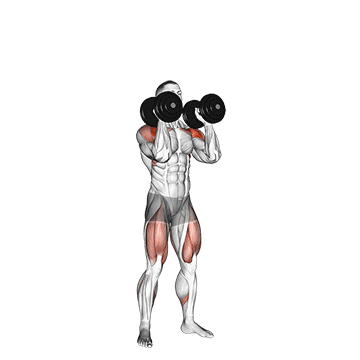
1. Start by standing upright with your feet shoulder-width apart.
2. Hold a dumbbell in each hand at shoulder level with your palms facing each other. Your elbows should be bent and your forearms vertical. This is your starting position.
3. Bend your knees slightly, then push up with your legs while pushing your arms up to lift the dumbbells above your head.
4. Extend your arms fully, but be careful not to lock your elbows.
5. Pause for a moment at the top of the movement, then slowly lower the dumbbells back to the starting position.
6. Repeat the movement for the desired number of repetitions.
Remember to keep your back straight and your core engaged throughout the exercise. The power for the push press should come from your legs and hips, not just your arms and shoulders.
dumbbell one arm upright row
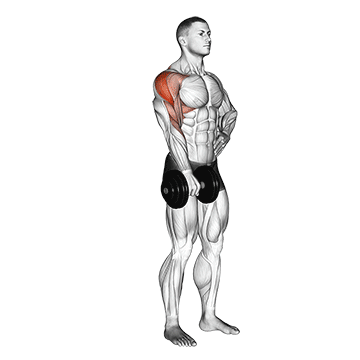
1. Stand upright with your feet shoulder-width apart. Hold a dumbbell in one hand with your palm facing your body. Your arm should be fully extended and the dumbbell should be resting against your thigh.
2. Keep your back straight and your core engaged throughout the exercise. This is your starting position.
3. Lift the dumbbell straight up by bending your elbow and raising your upper arm. Keep the dumbbell close to your body as you lift it. Your elbow should go higher than your shoulder and the dumbbell should reach about chest level.
4. Hold this position for a second, then slowly lower the dumbbell back to the starting position.
5. Repeat the movement for your desired number of repetitions.
6. Once you've completed your set, switch the dumbbell to your other hand and repeat the exercise.
Remember to keep your movements controlled, don't use your back or legs to lift the weight - the power should come from your shoulder and arm.
dumbbell one arm shoulder press v. 2
1. Stand upright with your feet shoulder-width apart. Hold a dumbbell in one hand, with your palm facing forward. Your elbow should be bent at a 90-degree angle, and your upper arm should be parallel to the floor. This is your starting position.
2. Exhale and push the dumbbell upward until your arm is fully extended above your head. Keep your back straight and avoid using your legs or back to help you lift the weight. The movement should be controlled, focusing on your shoulder muscles.
3. Pause for a moment at the top of the movement, then slowly lower the dumbbell back to the starting position as you inhale.
4. Repeat the movement for your desired number of repetitions.
5. Once you've completed your set, switch the dumbbell to your other hand and repeat the exercise.
Remember to keep your core engaged throughout the exercise to maintain balance and stability. Also, avoid locking your elbow at the top of the movement to keep tension on your shoulder muscles.
dumbbell one arm shoulder press
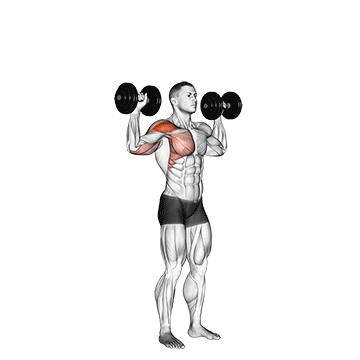
1. Start by standing or sitting on a bench with back support, holding a dumbbell in one hand. If you're standing, make sure your feet are shoulder-width apart for stability.
2. Raise the dumbbell to shoulder level with your palm facing forward. This is your starting position.
3. Exhale and push the dumbbell upward until your arm is fully extended above your head. Ensure your wrist is straight and the dumbbell is directly above your shoulder.
4. Pause for a moment at the top of the movement, then slowly lower the dumbbell back to the starting position while inhaling.
5. Repeat the movement for the desired number of repetitions.
6. Once you've completed your set, switch the dumbbell to your other hand and repeat the exercise.
Remember to keep your back straight and your core engaged throughout the exercise to protect your spine. Also, avoid locking your elbow at the top of the movement to prevent injury. The movement should be controlled, with the focus on the upward push and a slow, steady return to the starting position.
dumbbell one arm reverse fly (with support)
_Shoulders_360.gif)
1. Start by selecting a dumbbell of appropriate weight. Remember, it's better to start light and increase the weight as you get comfortable with the exercise.
2. Stand next to a flat bench or any sturdy surface that you can lean on for support. Hold the dumbbell in your right hand.
3. Position yourself so that your left knee and left hand are resting on the bench. Your body should be parallel to the floor, with your right foot firmly planted on the ground for balance.
4. Hold the dumbbell in your right hand with your palm facing towards your body. Your arm should be hanging straight down towards the floor.
5. Keeping your back straight and your core engaged, slowly lift the dumbbell out to the side, keeping your elbow slightly bent. Continue lifting until your arm is parallel with the floor.
6. Pause for a moment at the top of the movement, then slowly lower the dumbbell back down to the starting position.
7. Repeat this movement for your desired number of repetitions. Once you've completed your set, switch sides and repeat the exercise with your left arm.
8. Remember to keep your movements slow and controlled, focusing on the contraction of your delt muscles. Avoid using momentum to lift the weight, as this can lead to injury and won't effectively target the intended muscles.
9. As with any exercise, it's important to breathe. Inhale as you lower the dumbbell and exhale as you lift it.
10. Always ensure you maintain proper form throughout the exercise to maximize its effectiveness and prevent injury.
dumbbell one arm lateral raise with support
1. Start by selecting a dumbbell of appropriate weight. Remember, it's better to start light and increase weight as you get comfortable with the movement.
2. Stand next to a sturdy object like a wall or a bench that you can use for support. Hold the dumbbell in the hand that's furthest from the support.
3. Position your feet shoulder-width apart and slightly bend your knees for stability. Keep your back straight and engage your core.
4. Lean slightly towards the support, placing your free hand on it for balance. Let the arm holding the dumbbell hang down naturally at your side, palm facing inwards.
5. Slowly raise the dumbbell out to your side, keeping your arm slightly bent at the elbow. Continue lifting until your arm is parallel with the floor. Ensure the movement is controlled and you're not using momentum to lift the weight.
6. Pause for a moment at the top of the movement, then slowly lower the dumbbell back to the starting position.
7. Repeat this movement for your desired number of repetitions. Once complete, switch sides and perform the same number of repetitions with the other arm.
8. Remember to keep your core engaged and your back straight throughout the exercise. The focus should be on your delts doing the work, not your back or other muscles.
9. For best results, incorporate this exercise into your upper body or shoulder workouts. Aim for 3-4 sets of 8-12 repetitions per side.
dumbbell one arm lateral raise
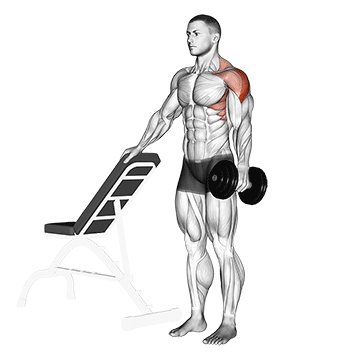
1. Stand upright with your feet shoulder-width apart. Hold a dumbbell in one hand, with your palm facing your torso. This is your starting position.
2. Keep your torso stationary and your elbow slightly bent, lift the dumbbell to your side until your arm is almost parallel to the floor or until you feel a strong contraction in your delts. Ensure your wrist stays neutral and the movement is controlled.
3. Pause for a moment at the top of the movement, then slowly lower the dumbbell back to the starting position.
4. Repeat the movement for the desired number of repetitions.
5. Once you've completed your set, switch the dumbbell to your other hand and repeat the exercise.
Remember to keep your back straight and your core engaged throughout the exercise. Avoid using your back or tilting your body to lift the weight; your delts should be doing the work. If you find yourself doing this, consider using a lighter weight.
dumbbell lying rear lateral raise
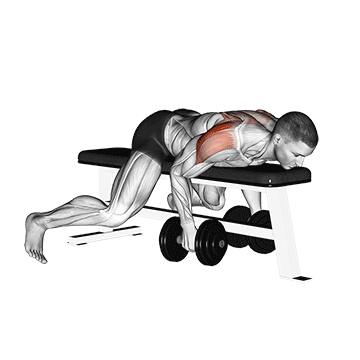
To perform the dumbbell lying rear lateral raise, follow these steps:
1. Start by selecting a pair of dumbbells of appropriate weight. Remember, it's better to start light and increase weight as you get comfortable with the movement.
2. Lie down on a flat bench with your chest and stomach pressed against the bench. Your feet should be flat on the floor.
3. Hold the dumbbells directly under your chest with your palms facing each other. This is your starting position.
4. Keeping your elbows slightly bent, raise the dumbbells to your sides until your arms are parallel to the floor. Ensure that the movement is performed by the shoulder joint, not your arms or wrists.
5. Hold the top position for a second, squeezing your shoulder blades together.
6. Slowly lower the dumbbells back to the starting position. This completes one rep.
7. Repeat for the desired number of repetitions.
Remember to keep your head down and neck relaxed throughout the exercise to avoid strain. The focus should be on your delts doing the work, not your neck or back.
dumbbell lying one arm rear lateral raise
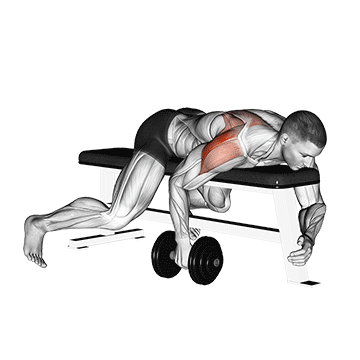
1. Start by selecting a dumbbell of appropriate weight. Remember, it's better to start light and increase weight as you get comfortable with the exercise.
2. Lie down on your side on a flat bench with your legs extended and feet on the floor for stability. The arm on the side you're lying should be holding the dumbbell.
3. Extend the arm holding the dumbbell straight down towards the floor. This is your starting position.
4. Keeping your arm slightly bent, raise the dumbbell up and out to the side until it's at shoulder level. Ensure to exhale as you perform this step.
5. Pause for a moment at the top of the movement, then slowly lower the dumbbell back to the starting position while inhaling.
6. Repeat the movement for the desired number of repetitions.
7. Once you're done, switch sides and repeat the exercise with the other arm.
Remember to keep your core engaged throughout the exercise and avoid any jerky movements. The focus should be on your delts doing the work, not momentum.
dumbbell lying one arm deltoid rear
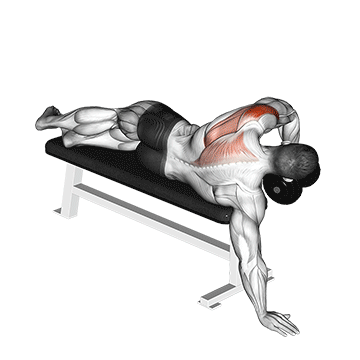
1. Start by selecting a dumbbell of appropriate weight. Remember, it's always better to start light and gradually increase the weight as you get comfortable with the exercise.
2. Lie down on a flat bench on your left side. Hold the dumbbell in your right hand. Your left arm should be extended straight on the bench for support.
3. Keep your right arm bent at a 90-degree angle, with the dumbbell hanging down and your palm facing inwards towards your body.
4. Slowly lift the dumbbell up in an arc motion until your arm is parallel to the floor. Ensure that the movement is controlled and you're using your deltoid muscle to lift the weight.
5. Hold the position for a second at the top of the movement, then slowly lower the dumbbell back to the starting position.
6. Repeat the exercise for your desired number of repetitions. Once you're done, switch sides and repeat the exercise with your left arm.
7. Remember to keep your core engaged throughout the exercise to maintain balance and stability. Also, ensure that your back is flat against the bench and your head is relaxed.
8. Avoid using momentum or swinging the weight. The movement should be slow and controlled, focusing on the muscle contraction and relaxation.
9. Breathe in as you lower the dumbbell and breathe out as you lift it. This will help you maintain a steady rhythm and provide your muscles with the oxygen they need.
10. Always ensure to warm up before starting the exercise and cool down afterwards to prevent injury and promote muscle recovery.
dumbbell lying on floor rear delt raise
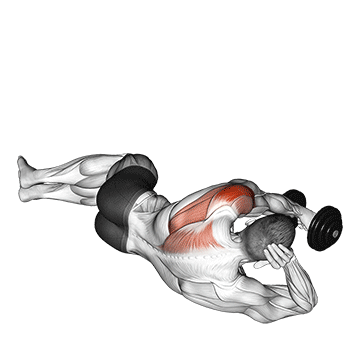
1. Start by selecting a pair of dumbbells of appropriate weight. Remember, it's better to start light and increase weight as you get comfortable with the exercise.
2. Lie down flat on your stomach on a bench or mat, with your arms extended in front of you. Each hand should be holding a dumbbell, palms facing each other.
3. Keep your feet flat on the floor or resting on the bench, depending on your comfort.
4. With a slight bend in your elbows, raise the dumbbells in a wide arc until they are level with your body. Your arms should be perpendicular to your body, forming a T shape. This is the top of the movement.
5. Hold this position for a second, squeezing your shoulder blades together to engage your rear deltoids.
6. Slowly lower the dumbbells back to the starting position in a controlled manner. This completes one rep.
7. Aim for 3 sets of 10-12 reps, ensuring to maintain proper form throughout.
Remember, the key to this exercise is control and form, not speed or the amount of weight. Always keep your movements slow and controlled to fully engage your rear delts and avoid injury.
dumbbell lying external shoulder rotation
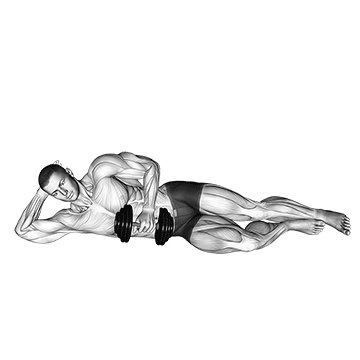
1. Start by selecting a dumbbell of appropriate weight. Remember, it's better to start light and gradually increase the weight as you get comfortable with the exercise.
2. Lie down on your side on a flat bench with your head supported. Your legs should be slightly bent for stability.
3. Hold the dumbbell in your top hand, keeping your elbow at a 90-degree angle. Your upper arm should be parallel to the floor, resting against your side, and your forearm perpendicular to it, holding the dumbbell above the floor.
4. Slowly rotate your shoulder to lift the dumbbell up, keeping your elbow firmly against your side. The movement should be like opening a door, with your forearm as the door and your elbow as the hinge.
5. Lift the dumbbell until your forearm is parallel with the floor or as far as comfortable. Ensure the movement is controlled and avoid any jerky motions.
6. Hold this position for a moment, then slowly lower the dumbbell back to the starting position.
7. Repeat this movement for your desired number of repetitions. Once you've completed a set, switch sides and perform the exercise with your other arm.
8. Remember to keep your core engaged throughout the exercise to maintain stability and ensure the focus remains on your delts.
Note: Always consult with a fitness professional if you're unsure about the correct form or weight for this exercise.
dumbbell lateral to front raise
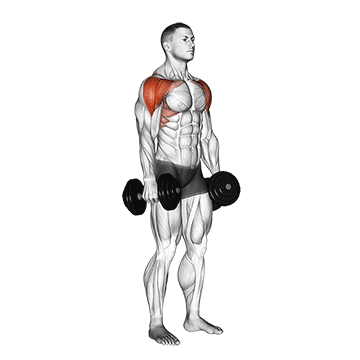
To perform the dumbbell lateral to front raise, start by standing straight with your feet shoulder-width apart. Hold a dumbbell in each hand with your palms facing towards your body. This is your starting position.
First, raise the dumbbells out to your sides until they reach shoulder height, keeping your arms almost fully extended. Ensure your torso remains stationary and only your arms are moving. This is the lateral raise.
Next, slowly lower the dumbbells back down to your sides. Then, without pausing, raise the dumbbells straight in front of you until they are at shoulder height. This is the front raise.
Lower the dumbbells back down to your sides. This completes one repetition.
Remember to keep your movements controlled, don't use your back or momentum to lift the weights. Your shoulders should be doing the work.
Perform 3 sets of 10-12 repetitions, or as many as you can manage with good form. Rest for 60 seconds between sets.
This exercise targets your deltoid muscles, which are located in your shoulders. It's important to use a weight that is challenging but allows you to complete the exercise with proper form. If you're new to this exercise, start with a lighter weight and gradually increase as you become stronger.
dumbbell lateral raise
1. Stand upright with your feet shoulder-width apart. Hold a dumbbell in each hand with your arms fully extended at your sides. Your palms should be facing your body. This is your starting position.
2. Keeping your torso stationary, lift the dumbbells to your side with a slight bend on your elbow and the hands slightly tilted forward. Continue to lift them until they are at shoulder level. Ensure you exhale as you perform this movement and hold the contraction at the top for a second.
3. Slowly lower the dumbbells back down to the starting position while inhaling.
4. Repeat this movement for the recommended amount of repetitions.
Remember to keep your torso stationary and your movements controlled. The focus should be on the contraction and relaxation of the deltoid muscles, not on the arms or dumbbells.
dumbbell iron cross
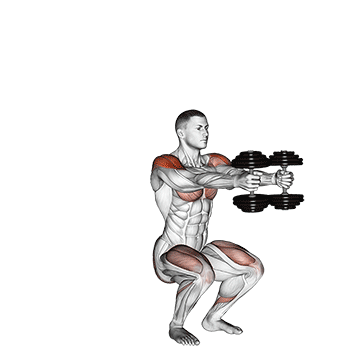
To perform the Dumbbell Iron Cross exercise, follow these steps:
1. Stand upright with your feet shoulder-width apart. Hold a dumbbell in each hand with your palms facing your body. This is your starting position.
2. Keeping your arms straight, lift the dumbbells out to your sides and up until they are at shoulder height. Your body should form a "T" shape.
3. Hold this position for a second, ensuring that your shoulder muscles are engaged.
4. Slowly lower the dumbbells back down to your sides in a controlled manner.
5. Repeat this movement for the desired number of repetitions.
Remember to keep your back straight and your core engaged throughout the exercise. Avoid using your back or swinging your body to lift the weights; your shoulders should be doing the work. Choose a weight that is challenging but allows you to maintain good form.
dumbbell incline t-raise
To perform the dumbbell incline T-raise, follow these steps:
1. Start by setting an incline bench at a 45-degree angle.
2. Grab a pair of dumbbells with a weight that you're comfortable with. Remember, it's not about the weight but the correct form and technique.
3. Sit on the bench with your chest and stomach pressed against the incline. Let your arms hang straight down, holding the dumbbells. This is your starting position.
4. Keep your back flat and your core engaged throughout the exercise.
5. Slowly raise the dumbbells out to your sides, keeping your arms straight. Continue to lift until your arms are parallel to the floor and form a 'T' shape with your body.
6. Pause for a moment at the top of the movement, then slowly lower the dumbbells back to the starting position.
7. Repeat this movement for your desired number of repetitions.
Remember to keep your movements slow and controlled, focusing on the contraction of your deltoid muscles. Avoid using your back or momentum to lift the weights; your shoulders should be doing the work.
dumbbell incline rear lateral raise
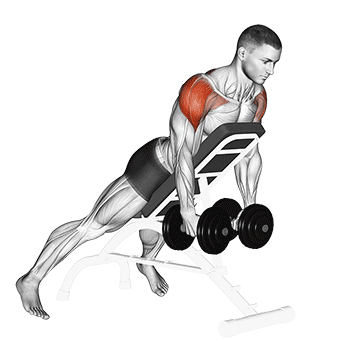
1. Start by selecting a pair of dumbbells of appropriate weight. Remember, it's better to start light and increase weight as you get comfortable with the movement.
2. Sit on an incline bench set at about 45 degrees. Hold the dumbbells in each hand with your palms facing each other.
3. Bend forward at the waist so your chest is leaning into the incline bench. Let your arms hang down holding the dumbbells. This is your starting position.
4. Keeping your torso stationary, lift the dumbbells to your side with a slight bend on your elbow and your hands slightly tilted forward as if pouring water in a glass. Continue to go up until your arms are parallel to the floor. Exhale as you perform this movement and pause for a second at the top.
5. Lower the dumbbells back down slowly to the starting position as you inhale.
6. Repeat for the recommended amount of repetitions.
Remember to keep your back straight and your movements controlled. Avoid using your back or shoulders to lift the weights; your arms should do all the work. This exercise should be done slowly for maximum effect.
dumbbell incline raise
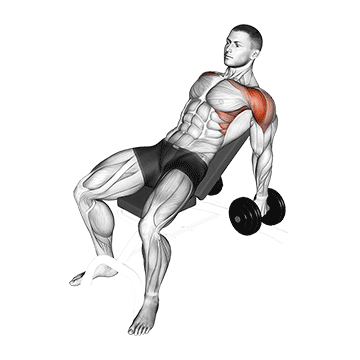
To perform the dumbbell incline raise, start by selecting a pair of dumbbells of appropriate weight. Sit on an incline bench set at an angle of about 45 degrees.
Hold the dumbbells in each hand with your palms facing inwards towards your body. Your arms should be fully extended with a slight bend at the elbows, and the dumbbells should be directly under your shoulders. This is your starting position.
Slowly lift the dumbbells to the side, keeping your arms slightly bent at the elbows. Continue to lift them until they are at shoulder level and your body forms a "T" shape. Ensure your torso remains stationary and only the arms move. The lift should be performed with the deltoid muscles rather than the arms.
Pause for a moment at the top of the movement, then slowly lower the dumbbells back to the starting position.
Remember to breathe in as you lift the dumbbells and breathe out as you lower them.
Repeat this movement for the desired number of repetitions.
Ensure to maintain control of the dumbbells at all times, do not allow them to fall or drop quickly. This exercise should be performed in a slow and controlled manner for the best results.
dumbbell incline one arm lateral raise
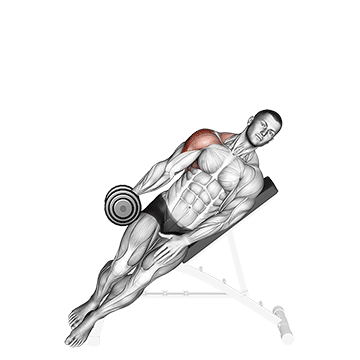
1. Start by selecting a dumbbell of appropriate weight. Remember, it's better to start light and increase weight as you get comfortable with the movement.
2. Sit on an incline bench set at about 45 degrees. Hold the dumbbell in one hand, letting it hang down at arm's length. Your other hand can grip the side of the bench for stability.
3. Keep your back firmly against the bench and your feet flat on the floor. This is your starting position.
4. Slowly raise the dumbbell out to your side, keeping your arm slightly bent at the elbow. Continue lifting until your arm is parallel with the floor. Ensure your wrist, elbow, and shoulder are in a straight line.
5. Pause at the top of the movement for a second, then slowly lower the dumbbell back to the starting position.
6. Repeat the movement for your desired number of repetitions. Once complete, switch to the other arm and perform the same number of repetitions.
7. Remember to keep your core engaged throughout the exercise to maintain balance and stability. Also, avoid using momentum to lift the weight; the movement should be controlled and deliberate.
8. This exercise can be performed in sets of 8-12 repetitions, depending on your fitness level and goals.
Remember, the focus of this exercise is on the delts, so ensure you're feeling the contraction in this muscle group and not straining your neck or other parts of your body.
dumbbell full can lateral raise
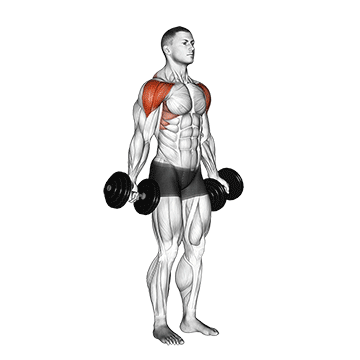
To perform the dumbbell full can lateral raise, start by standing straight with your feet shoulder-width apart. Hold a dumbbell in each hand with your arms fully extended and the palms of your hands facing forward. This is your starting position.
Slowly lift the dumbbells to the side until your arms are parallel to the floor. Keep your elbows slightly bent and your hands directly under your elbows at the top of the movement. Ensure your body is stable and your movement is controlled.
Pause for a moment at the top of the movement, then slowly lower the dumbbells back to the starting position. This completes one repetition.
Remember to breathe in as you lift the dumbbells and breathe out as you lower them.
Perform this exercise for the recommended number of repetitions and sets for your fitness level. Be sure to choose a weight that is challenging but allows you to maintain proper form throughout the exercise.
This exercise targets the deltoid muscles in your shoulders. Be careful not to use your back or swing the weights to lift them, as this can lead to injury. Instead, focus on using your shoulder muscles to lift the weights.
dumbbell front raise v. 2
To perform the dumbbell front raise v. 2, start by standing straight with your feet shoulder-width apart. Hold a dumbbell in each hand with your palms facing your body. Your hands should be slightly less than shoulder-width apart.
Engage your core and keep your back straight throughout the exercise. This is your starting position. Slowly raise one dumbbell in front of you, keeping your arm straight and your elbow slightly bent. Continue to lift the dumbbell until your arm is slightly above parallel to the floor.
Pause for a moment at the top of the movement, then slowly lower the dumbbell back to the starting position. As you lower one dumbbell, begin to raise the other in the same manner. This is one repetition.
Ensure that you are lifting the dumbbells with your delts, not your biceps. Avoid using your back or swinging the weights to lift them. Instead, focus on a slow, controlled movement.
Repeat this exercise for the desired number of repetitions. Remember to breathe in as you lower the dumbbells and breathe out as you lift them.
dumbbell front raise
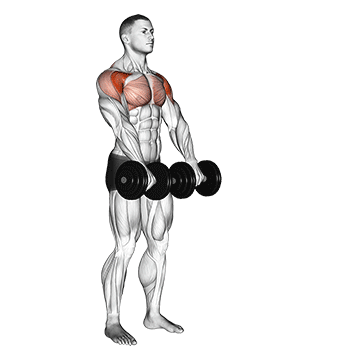
To perform the dumbbell front raise, start by standing straight with your feet shoulder-width apart. Hold a dumbbell in each hand with your palms facing your body. This is your starting position.
Slowly lift the dumbbells in front of you while keeping your arms slightly bent at the elbows. Continue to lift the weights until your arms are slightly above parallel to the floor. Ensure that you are lifting the weights with your shoulders and not your biceps.
Pause for a moment at the top of the movement, then slowly lower the dumbbells back to the starting position.
Remember to keep your torso stationary throughout the exercise. Avoid swinging the weights or using your body momentum to lift them. Instead, focus on isolating your deltoid muscles during the movement.
Repeat this exercise for the recommended number of repetitions.
For safety, choose a weight that allows you to perform the exercise with proper form. If you're new to this exercise, start with lighter weights and gradually increase as you become more comfortable with the movement.
dumbbell cuban press v. 2
To perform the Dumbbell Cuban Press V. 2, follow these steps:
1. Stand upright with your feet shoulder-width apart. Hold a dumbbell in each hand with your palms facing your torso.
2. Bend your elbows to a 90-degree angle, keeping your upper arms parallel to the ground. This is your starting position.
3. Without changing the angle of your elbows, rotate your shoulders to lift the dumbbells until your arms are vertical. Your palms should now be facing forward.
4. Press the dumbbells straight up above your head until your arms are fully extended. Be careful not to lock your elbows.
5. Lower the dumbbells back to the vertical position, then rotate your shoulders to return to the starting position.
6. Repeat for the desired number of repetitions.
Remember to keep your core engaged and your back straight throughout the exercise. Choose a weight that is challenging but allows you to maintain good form. This exercise targets the delts, or shoulder muscles, and also works the upper back and arms.
dumbbell cuban press
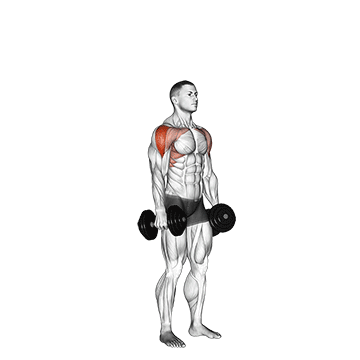
To perform the Dumbbell Cuban Press, follow these steps:
1. Stand upright with your feet shoulder-width apart. Hold a dumbbell in each hand with your palms facing your torso.
2. Bend your elbows to lift the dumbbells to shoulder height, keeping your elbows out to the sides and your forearms parallel to the floor. This is your starting position.
3. Rotate your shoulders to raise the dumbbells until your arms are vertical. Your palms should now be facing forward.
4. Press the dumbbells straight up over your head until your arms are fully extended.
5. Lower the dumbbells back to the vertical position, then rotate your shoulders to return to the starting position.
6. Repeat for the desired number of repetitions.
Remember to keep your core engaged and your back straight throughout the exercise. Choose a weight that is challenging but allows you to maintain good form. If you're new to this exercise, start with lighter weights to get the movement down before increasing the weight.
dumbbell bench seated press
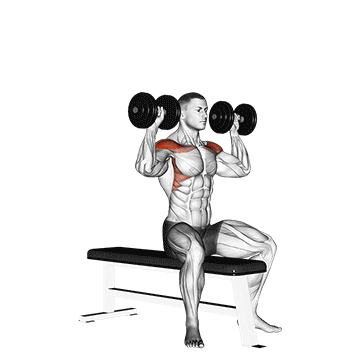
1. Start by sitting on a bench with a back support. Place your feet firmly on the floor and keep your back pressed against the bench.
2. Hold a dumbbell in each hand at shoulder level with your palms facing forward. This is your starting position.
3. Exhale and push the dumbbells up until your arms are fully extended above your shoulders. Ensure your wrists are straight and the dumbbells are parallel to each other.
4. Pause for a moment at the top of the movement, then slowly lower the dumbbells back to the starting position while inhaling.
5. Repeat this movement for the desired number of repetitions.
6. Ensure to keep your back flat against the bench throughout the exercise to avoid injury and to maximize the engagement of your delts.
Remember, it's not about the weight of the dumbbells, but the correct form and control of the movement. Start with lighter weights and gradually increase as you get stronger.
dumbbell arnold press v. 2
To perform the Dumbbell Arnold Press V. 2, follow these steps:
1. Start by standing up straight with a dumbbell in each hand, palms facing your torso. This will be your starting position.
2. Lift the dumbbells to shoulder height on each side, and twist the wrists so that the palms are facing forward.
3. Push the dumbbells up in a vertical line from your shoulders until your arms are fully extended above your head.
4. After a brief pause at the top contracted position, slowly lower the weights back down to the starting position while rotating your wrists so that the palms are facing your torso again.
5. Repeat for the recommended amount of repetitions.
Remember to keep your back straight and your movements controlled. Don't use your back or legs to push the weights up; your shoulders should do all the work. The rotation of the wrists ensures that all three heads of the delts are hit during the exercise.
dumbbell arnold press
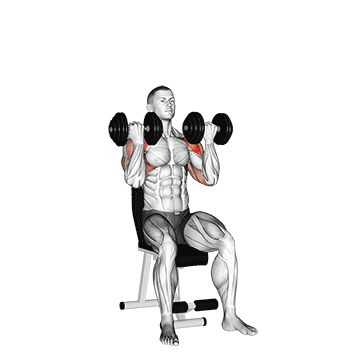
1. Start by selecting a pair of dumbbells that you can comfortably lift. Stand or sit on a bench with your back straight.
2. Hold the dumbbells in front of you at about upper chest level with your palms facing your body and your elbows bent. This is your starting position.
3. Raise the dumbbells as you rotate the palms of your hands until they are facing forward. Continue lifting the dumbbells until your arms are extended above you in straight arm position. Breathe out as you perform this portion of the movement.
4. After a second pause at the top, begin to lower the dumbbells to the original position by rotating the palms of your hands towards you. The left dumbbell should be rotating to your left and the right one to your right. Breathe in as you perform this portion of the movement.
5. Repeat for the recommended amount of repetitions.
Remember to keep your back and head straight throughout the exercise to avoid injury. The rotation of the hands should be fluid and controlled, not fast and jerky. The dumbbells should be lowered to the same position they started in, at upper chest level.
dumbbell alternate side press
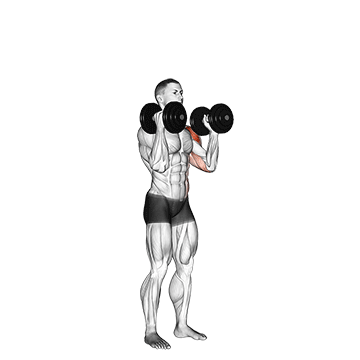
1. Start by standing upright with your feet shoulder-width apart. Hold a dumbbell in each hand at shoulder level with your palms facing each other.
2. Keep your back straight and engage your core. This is your starting position.
3. Push one dumbbell upwards until your arm is fully extended, while keeping the other dumbbell at shoulder level. As you press the dumbbell, rotate your wrist so that your palm is facing forward at the top of the movement.
4. Slowly lower the dumbbell back to the starting position while simultaneously pressing the other dumbbell upwards. Rotate your wrist so that your palm is facing forward at the top of the movement.
5. Continue alternating sides for the desired number of repetitions.
6. Remember to keep your back straight and your core engaged throughout the exercise to protect your spine and maximize the effectiveness of the exercise.
7. Breathe out as you press the dumbbell upwards and breathe in as you lower it back down.
This exercise targets the deltoid muscles in your shoulders. Make sure to use a weight that is challenging but allows you to maintain proper form.
No tags for this post.
